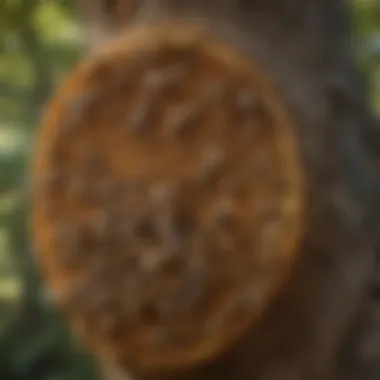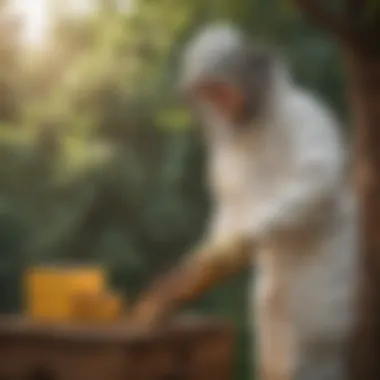Effective Strategies for Removing Beehives from Trees


Intro
Removing beehives from trees requires careful consideration to ensure the safety of both humans and bees. Bees play a crucial role in our ecosystem as pollinators, but there are times when their hives are located in inconvenient or dangerous areas. This section offers an overview of effective strategies to approach hive removal while balancing ecological responsibilities and human safety. Understanding the importance of responsible management can help guide decisions about when to remove a hive and how best to do so.
Animal Species Profile
Foreword to bees
Bees are fascinating insects belonging to the order Hymenoptera and play a vital role in pollination. There are approximately 20,000 species of bees worldwide, but honeybees and bumblebees are the most commonly recognized. These species not only contribute to the reproduction of many flowering plants but are also essential for agricultural production. By understanding their biology and habits, individuals can make better-informed decisions regarding hive removal.
Physical characteristics and appearance
Honeybees, for example, exhibit a distinct golden-brown appearance with a fuzzy body that helps carry pollen. Their wings are transparent, and they have a characteristic stinger, which they use primarily for defense. Bumblebees are usually larger and more robust than honeybees, often sporting black and yellow stripes. Each species has specific traits that make them unique, influencing their behavior and environmental role.
Natural habitat and distribution
Bees are found in diverse habitats around the globe ranging from urban gardens to wildflower fields. Honeybees tend to build hives in protected locations such as tree cavities or man-made structures. Bumblebees, on the other hand, often select underground spaces with ample flowering resources nearby. Understanding where these bees thrive can help assess the environmental context surrounding a particular hive.
Behavior and social interactions
Bees exhibit complex social behaviors. Honeybees live in large colonies, working together in a highly organized structure. The queen bee lays eggs, workers forage for food, and drones fulfill the role of mating. Bumblebees tend to live in smaller colonies, and their social structure is less rigid. Observing these behaviors contributes to a broader understanding of their role in ecosystems, especially when considering hive removal.
Conservation & Wildlife Efforts
Overview of conservation status
Many bee species face population declines due to habitat loss, pesticide exposure, and climate change. Understanding the conservation status of bees is essential for effective hive management. Protecting bee populations is crucial, considering their ecological importance.
Threats to the species
The threats to bees include:
- Pesticides: Chemicals can be fatal to bees and disrupt their natural behaviors.
- Habitat Loss: Urban development and agricultural practices limit their foraging and nesting areas.
- Climate Change: Changing weather patterns affect the availability of food sources.
Conservation initiatives and organizations
Several groups work towards the protection of bee populations. For instance, the Xerces Society advocates for the conservation of bees and other invertebrates. Their work involves research, educational outreach, and policy advocacy, aiming to improve conditions for bee survival.
Success stories and impact
Successful initiatives have led to improved habitats in certain regions, showing that informed action can result in positive outcomes for bee populations. Restoration of native flora in urban areas is one such example where efforts have dramatically increased bee activity.
Animal Behavior & Psychology
Communication and language cues
Bees communicate primarily through dances, such as the waggle dance. This dance conveys information about food sources’ distance and direction. Understanding these communication methods is essential for recognizing their needs and addressing hive removal.
Reproductive behavior and parenting
The reproductive process of bees is particularly interesting. The queen bee determines the hive's population by laying eggs, while worker bees care for the brood. This social structure exemplifies the division of labor that fuels the colony's survival.
Cognitive abilities and problem-solving skills
Research indicates bees possess impressive cognitive abilities, including solving puzzles and learning from experiences. This intelligence can be beneficial in understanding how to approach hive removal without causing unnecessary stress to the bees.
Emotional intelligence and social dynamics
Studies suggest that bees exhibit behaviors that demonstrate social awareness and collective decision-making. This understanding can promote more humane approaches to hive management, as bees respond dynamically to their environment and social cues.
Unique Facts & Trivia
Little-known facts about the animal
Many people do not realize that bees can recognize human faces. This ability enhances their survival by helping them identify threats and ensure their safety.
Surprising behaviors or adaptations
Some bee species can tolerate colder climates by entering a dormant state. This adaptation allows them to survive harsh winters and emerge when conditions improve.


Fun trivia and quirky behaviors
Bees have a unique way of regulating hive temperature. When it gets too hot, they can fan their wings to cool the hive. This behavior reflects their cooperative nature.
Record-breaking feats or abilities
Honeybees, in particular, can fly up to 15 miles per hour. This impressive speed allows them to travel great distances in search of nectar and pollen.
Pet Care & Tips
While not pets in a conventional sense, understanding bee care and management can enhance human interactions with these pollinators.
Choosing the right approach for hive management is essential for maintaining safety and ecological balance. \n Be cautious and consider calling professionals for hive removal if the hive poses a risk. Recognizing the signs of a hive's proximity to human dwellings can guide timely intervention.
In summary, removing beehives from trees is a complex process requiring knowledge of bee behavior, conservation efforts, and community safety. Harmonizing human needs with environmental considerations is crucial. By adopting responsible management practices, it is possible to ensure the well-being of both society and these essential pollinators.
Understanding the Importance of Bees
In the discourse around beehive removal, it is vital to first understand the intrinsic value of bees. These insects do not just produce honey; they play crucial roles in ecosystems and agriculture. Removing a beehive, particularly from its natural habitat, requires careful consideration of various factors that underscore their importance.
Bees are responsible for pollinating a significant portion of the plants we rely on for food. According to estimates, about one-third of global food production depends on bee pollination. This includes fruits, vegetables, and nuts. As such, safeguarding bee populations is essential for food security and agricultural diversity.
Furthermore, bees contribute to the overall health of ecosystems. They enable biodiversity by assisting in the reproduction of flowering plants, many of which serve as the foundational elements of various habitats. Healthy bee populations ensure that a range of plant species thrives, subsequently supporting a wide array of animal species.
Moreover, bees are indicators of environmental health. Their presence often signifies a balanced ecosystem. Therefore, understanding the ecology surrounding bees is crucial when discussing removal strategies. Practitioners must weigh the potential benefits of hive removal against the environmental losses that may follow.
The Ecological Role of Bees
The ecological contributions of bees extend beyond mere pollination. They help in maintaining the genetic diversity of plants. This genetic variation is essential for resilient ecosystems, especially in the face of climate change and other environmental stressors.
- Bees engage in cross-pollination, facilitating genetic exchange between plant populations. This mechanism enhances the adaptability of plant species, enabling them to resist pests and diseases. A decline in bee populations could therefore, have far-reaching effects on natural biodiversity and ecosystem functions.
- In addition, many plants have evolved specific relationships with bees. Some plants are dependent on particular bee species for their reproduction. This interdependence illustrates the intricate web of life in which bees play an essential role, thus highlighting the need for thoughtful hive management.
Impact of Bees on Biodiversity
The impact of bees on biodiversity is profound. They not only support the richness of flora but also impact faunal communities. Bees influence the structure of ecosystems by determining plant community compositions.
- Pollination can affect which plants thrive and which decline. Consequently, this influences the availability of food resources for herbivores, which in turn affects predators in the food chain.
- A decline in bee populations can lead to reduced plant diversity, which can cause cascading effects within ecosystems. The unique relationships between species can easily become disrupted, leading to a decrease in ecological stability.
Identifying the Presence of a Beehive in a Tree
Identifying a beehive in a tree is essential for anyone dealing with bee-related concerns. Understanding how to spot these hives can prevent accidental confrontations with bees and can inform decisions about whether removal or management is necessary. The process generally involves two approaches: spotting physical signs and observing behavioral indicators. Knowing what to look for can save time and ensure safety, both for humans and for the bees themselves.
Physical Signs of a Beehive
Physical signs are often the first clues that alert you to the presence of a beehive. Recognizing these can help you make informed decisions.
- Wax and Honey: Look for wax scales on leaves and nearby surfaces. They are often yellowish or white in color. Honey spills are also a clear indication of a hive's location.
- Bee Droppings: Dark stains on trunk or ground can be a sign. Bee droppings resemble small dots and can give away hive activity.
- Unusual Activity: Increased bee activity around a tree, especially in warm weather, is a strong indicator. Observing bees entering and exiting consistently points to the existence of a hive.
- Scent: A distinct sweet smell associated with honey may be noticeable. This can be particularly strong near the hive.
Recognizing these signs early is valuable for proper action planning.
Behavioral Indicators of Bees
Observing bee behavior is critical in identifying a hive's presence. Different types of bees display unique behaviors that can signal an active hive nearby.
- Flight Patterns: Watch how bees fly. If they have a direct route to a specific tree, this could indicate a source of nectar or a hive.
- Buzzing Sounds: Listen for a low, buzzing noise that persists. This sound can be a clear sign of hive activity and indicates that bees are present and active in the tree.
- Guard Bees: Occasionally, certain bees will act defensively around the hive entrance. If you notice aggressive behavior from bees, it may signal that you are nearby their home.
Identifying a beehive in a tree requires keen observation of both physical and behavioral signs. This knowledge is essential for any subsequent action, ensuring that the situation is handled appropriately without unnecessary harm to the bees.
Assessing the Situation Before Removal
Before attempting to remove a beehive from a tree, it is crucial to conduct a thorough assessment of the situation. This process involves understanding various factors, including the size and location of the hive, the species of bees involved, and potential risks to both humans and the bees. Evaluating these elements ensures a safer and more effective removal process. Also, this step can help minimize stress for the bees, which is vital for their conservation.
Evaluating the Size and Location of the Hive
The size and location of the beehive play a significant role in determining the appropriate removal strategy. A large hive situated high in a tree may require different methods and safety precautions compared to a smaller hive located near ground level. Inappropriate evaluation could lead to accidents and may put individuals at risk of bee stings.
Consider these aspects when evaluating the hive:
- Hive Size: Larger hives often involve more bees, increasing the risk of aggressive behavior during removal.
- Location: Hives that are easily accessible allow for safer removal techniques, while hives in hard-to-reach areas may necessitate professional intervention.
- Surrounding Environment: Assessing nearby individuals, pets, and structures is essential. If the hive is near populated areas or vital infrastructure, safety measures must be heightened.


Understanding the hive's characteristics allows for a tailored approach to removal, significantly reducing potential hazards.
Understanding Bee Species Involved
Different bee species exhibit varied behaviors, which influences the removal process. Not all bees respond the same way to threats, and knowledge about the specific species involved can help determine whether to proceed with removal or seek professional help.
Consider these factors regarding bee species:
- Aggressiveness: Some species, like Africanized honeybees, are known for their defensive behavior, making them more challenging to manage.
- Species Protection: Certain species are protected by law. For instance, honeybees are crucial to pollination and biodiversity. This necessitates ethical considerations before removal. You may want to explore options like relocating the hive instead.
- Behavioral Traits: Learning about the hive's species helps in predicting the bees' responses during removal. This understanding equips individuals with strategies to minimize confrontations.
Understanding the specific bee species involved is crucial before deciding on methods for removal. Misjudging their behavior could lead to unsafe situations.
Evaluating both the hive's size and the species involved sets the foundation for a more informed, effective, and responsible hive removal process. Such careful consideration not only enhances human safety but also respects the ecological role that bees play in our environment.
Legal Considerations for Beehive Removal
When addressing beehive removal, a clear understanding of the legal landscape is crucial. Bees, particularly honeybees, are often protected under various regulations aimed at conserving their populations. In this section, we will explore the key legal elements relevant to removing beehives from trees.
Regulations on Honeybee Protection
Regulatory frameworks vary significantly across regions, but many countries recognize the importance of honeybees within the ecosystem. For instance, the European Union has enacted measures to safeguard honeybee habitats, ensuring that any removal process accommodates conservation efforts. Similar protective measures can be found in the United States, where legislation often emphasizes maintaining bee populations due to their role in pollination and biodiversity.
Considering local laws is vital before attempting hive removal. Failing to comply with these regulations can lead to fines and potential legal action. Always consult your local wildlife authority or legal expert to fully comprehend applicable laws.
Permits and Licenses for Removal
In many jurisdictions, permits may be required to legally remove a beehive. This is especially true if the hive is located in a sensitive area or if the bees are recognized as a protected species. Obtaining the proper permits ensures that removal is conducted responsibly and legally.
Steps to Obtain Necessary Permits:
- Research: Start by checking your local wildlife regulations regarding beehive removal.
- Consult Authorities: Contact local wildlife or environmental agencies for guidance on the permit application process.
- Submit Application: Fill out any required forms, providing detailed information about the hive and its location.
- Follow Up: After submitting the application, follow up to ensure you are informed of approval and any conditions attached.
Remember, legalities surrounding beekeeping and hive removal are meant to protect vital ecological roles bees perform.
Abiding by these regulations is not only a legal obligation but also part of ethically managing bee populations. Therefore, understanding the legal ramifications surrounding beehive removal can help you execute this task safely and lawfully.
Safety Precautions During Hive Removal
Removing a beehive from a tree requires careful planning and execution. Safety precautions are paramount not only for the individuals involved but also for the bees themselves. The risk of bee stings is significant, and it is essential to take measures to reduce this risk. Understanding the right protective gear and having a clear emergency plan can create a safer environment for all.
Protective Gear for the Task
Choosing the right protective gear is vital when undertaking beehive removal. This can greatly mitigate the chance of being stung. Here are some essential items:
- Bee Suit: A full-body bee suit is crucial. It should cover all exposed skin and be made of thick material to prevent stings.
- Veil: A helmet or veil must be worn to protect the face and neck. This is where stings can be quite painful and disruptive.
- Gloves: Thick gloves protect the hands. They should be bee-proof but allow for some dexterity to handle tools.
- Boots: Closed-toe boots prevent stings to the feet. Tucking pants into boots can also ensure bees cannot get inside clothing.
By having these items ready, one can significantly reduce the likelihood of injury during the removal process. Be prepared, as working with bees can be unpredictable.
Risk Assessment and Emergency Planning
Before beginning the hive removal process, conducting a thorough risk assessment is necessary. Each hive presents unique challenges based on its size, location, and the species of bees involved. Here are steps to consider:
- Assess the Environment: Look for nearby structures or people. Evaluate how these factors may impact the removal process.
- Bee Behavior: Different bee species react differently when disturbed. Understanding their behavior will help in managing unexpected situations.
- Emergency Contacts: Have contacts for local emergency services available in case anyone does get stung, or if the situation escalates.
- First Aid Kit: Keep a first aid kit on hand that specifically includes tools for treating bee stings.
Effective planning and risk assessment not only protect personal safety but also contribute to the ethical treatment of bees during the removal process.
By combining proper protective gear and comprehensive risk planning, the process of hive removal can be handled in a way that aims for safety, effectiveness, and adherence to ethical standards.
Methods to Remove Beehives from Trees
Removing beehives from trees is a delicate task that requires careful planning and consideration. The methods chosen can significantly impact both the safety of humans involved and the welfare of the bee population. Different strategies exist, and understanding their nuances is essential. Manual removal techniques, chemical approaches, and professional beekeeping services each present unique benefits and challenges. The decision on which method to use should consider factors such as the hive size, location, and the species of bees involved.
Manual Removal Techniques
Manual removal of beehives can be effective but requires careful execution. This approach is often preferred when the hive is small and easily accessible, minimizing risk to the individual performing the removal. Here are some key practices in manual removal:
- Preparation: Before attempting manual removal, gather essential tools like a hive tool, smoker, and protective clothing. The smoker is critical as it calms bees and reduces aggressive behavior.
- Timing: Optimal time for removal is during dusk or early morning when bees are less active.
- Technique: Begin by gently using the smoker near the hive entrance. As bees calm down, slowly detach the hive from the tree, keeping the brood frames intact whenever possible.
- Post-removal: After securing the hive, ensure the area is checked for any remaining bees that may need alternative management.
This method maintains a level of respect for the bee colony, allowing the bees potential chances for survival.


Chemical Removal Approaches
Chemical methods for hive removal involve using pesticides to eliminate bees. This approach should be considered a last resort, primarily due to ethical and environmental concerns. Here are some points associated with chemical removal:
- Chemical Understanding: If opting for this method, it is crucial to identify the chemical agents and their potential environmental impacts. Pyrethroids are commonly used pesticides, but they can be harmful to non-target species, including beneficial insects.
- Application: Application should be done at night when bees are less active. Spray the hive thoroughly while making sure to wear protective gear.
- Guidelines: Adhere strictly to manufacturer instructions concerning dosage and safety guidelines. Consider local regulations addressing chemical use around wildlife.
Pesticide use should always prioritize minimizing harm to the surrounding ecosystem as much as possible.
Using Professional Beekeeping Services
The safest and most effective strategy for removing beehives is often to enlist professional beekeeping services. Experts in this field have the experience and knowledge necessary for effective hive removal. Here are the advantages of hiring professionals:
- Expertise: Beekeepers understand the behaviors of different bee species and can assess the best approach for hive removal while ensuring minimum exposure to aggression.
- Equipment: Professionals come equipped with proper tools and protective gear, making the process safer for all involved.
- Relocation: Many professionals focus on relocating the beehive rather than exterminating the bees. This practice supports bee conservation and aligns with ethical considerations.
- Post-removal Support: After removal, they can provide advice on how to prevent bees from nesting in the area again and offer education on local bee preservation efforts.
Aftercare and Habitat Restoration
After the removal of a beehive from a tree, it is vital to address the aftermath through proper aftercare and habitat restoration. This phase is not only about removing the hive itself but also about ensuring the tree and its surrounding environment remain healthy and conducive to local wildlife.
Reinforcing the Tree Structure
Once the hive is removed, one might notice damage to the tree's structure. The process of extraction can leave behind wounds, which may serve as entry points for pests or diseases. To mitigate this, it is essential to treat these wounds properly.
Some effective strategies include:
- Applying Tree Wound Sealant: This helps to protect the exposed areas from environmental factors.
- Support Staking: If the tree shows signs of weakening or swaying, installing temporary stakes can help maintain its stability as it heals.
- Regular Inspection: Monitor the tree’s health for signs of decay or disease. Addressing these issues early can prolong the life of the tree.
Ultimately, reinforcing the tree structure ensures it regains strength and resilience, allowing it to continue supporting local ecosystems.
Monitoring the Area for New Hives
Monitoring the area for new hives contributes to effective management of the bee population and addresses potential conflicts with humans. Bees, being naturally inclined to seek out suitable habitats, may attempt to establish new colonies in the same vicinity.
Several best practices include:
- Regular Observation: Periodically check the tree and surrounding areas for signs of bee activity. Look for buzzing sounds or bees flying in and out of potential hive locations.
- Install Bee Deterrents: Certain natural deterrents, such as peppermint oil, can discourage bees from nesting in unwanted areas.
- Educating the Community: Spread awareness about observing bee behavior and reporting new hive establishments promptly. This collective vigilance can help manage bee populations responsibly.
"Responsible aftercare not only benefits the tree but also helps maintain ecological balance in the area."
In summary, aftercare and habitat restoration are crucial in the aftermath of beehive removal. By reinforcing the tree structure and actively monitoring the area, individuals can ensure minimal disruption to both the tree and bee populations. This comprehensive approach reflects a commitment to ecological integrity and responsible wildlife management.
Ethical Considerations in Hive Removal
When addressing the issue of beehives located in trees, it is essential to explore the ethical considerations involved in their removal. Understanding the implications of removing a hive goes beyond practical concerns about safety and legality. This aspect of honeybee management involves weighing the impact on bee populations against human needs and addressing potential conflicts that may arise in urban and rural settings. Such considerations ensure that hive removal is conducted with respect for the ecological role bees play.
For many individuals, removing a hive can stem from a need for safety or to utilize the space the bees occupy. However, it is critical to recognize that bees are vital pollinators and contribute significantly to the health of ecosystems. Their decline poses risks to biodiversity, agriculture, and ultimately, the health of the planet. Thus, any decision related to hive removal should be made with a clear understanding of how it affects bee welfare and the environment.
One benefit of contemplating ethical concerns is that it promotes responsible action. Educating oneself on the status of bees, their species, and their habitats can lead to better decision-making regarding hive removal. Such awareness helps minimize harm to bee populations while addressing human needs. Furthermore, local communities benefit from initiatives that prioritize bee conservation, as this can instigate positive relationships between people and wildlife.
"The health of our ecosystems hinges on the preservation of bees, which underscores the importance of ethical hive management."
Consideration also extends to community impact. A responsible hive removal process acknowledges the significance of maintaining safe environments for both people and wildlife. In addition, understanding local regulations regarding bee protection can guide ethical practices. Areas with high bee diversity might have specific laws that stress the importance of conserving particular species.
In summary, ethical considerations in hive removal are critical for striking a balance between human needs and the preservation of bee populations. Engaging with those considerations ensures that individuals act responsibly and that community interests align with environmental sustainability.
Balancing Human Needs with Bee Conservation
In the delicate interplay between human activity and nature, balancing human needs with bee conservation is vital. Communities may face situations where beehives threaten public safety, like in parks, residential areas, or agricultural zones. While the instinct might be to eliminate the hive swiftly, this action needs reflective thought on environmental consequences.
First, we must acknowledge that bees generally prefer locations that provide safety and resources. This affinity can lead to hives in areas where humans engage in leisure or work. Therefore, it is essential to first assess whether the hive poses a genuine risk or if mitigation strategies can be employed. Educating the public on bee behavior and increasing awareness can reduce fear and promote coexistence.
Engagement in community partnerships can also facilitate harmony. Programs aimed at coexistence can empower individuals to adopt alternative strategies. For example, an individual can use barriers around high-activity areas to limit close encounters. Rather than resorting to removal, fostering understanding creates avenues for peaceful resolution.
Additionally, employing professionals who possess extensive knowledge about bee behavior and removal techniques can ensure the ethical handling of these insects. Their intervention often results in relocating hives to more suitable environments, where bees can thrive without posing a threat to human activities.
Community Education on Bee Preservation
Education is a cornerstone for promoting bee preservation within local communities. Awareness initiatives can significantly alter how people view bees – transitioning them from pests to beneficial wildlife. Through workshops, informational sessions, and community events, knowledge can be disseminated effectively.
Three key components of effective community education include:
- Understanding bee biology: Educating the public about bee lifecycle, species diversity, and habits can foster appreciation.
- Pollination importance: Highlighting the role of bees in pollinating crops and maintaining habitats illustrates their significant contributions.
- Safe hive management: Demonstrating practices that allow for coexistence, addressing removal methods, and showing how to manage minor infestations can ease tension surrounding their presence.
By investing in community education, residents may develop a deeper understanding and respect for bees. In turn, this knowledge can help limit unnecessary hive removals while supporting local biodiversity. Enhanced public perception and appreciation can lead to greater advocacy for protective measures and regulations. Consistent education serves to forge a cooperative ecosystem where humans can live alongside bees.
In summary, community education cultivates a culture of respect and protection for bees, ultimately laying the groundwork for sustainable coexistence.







